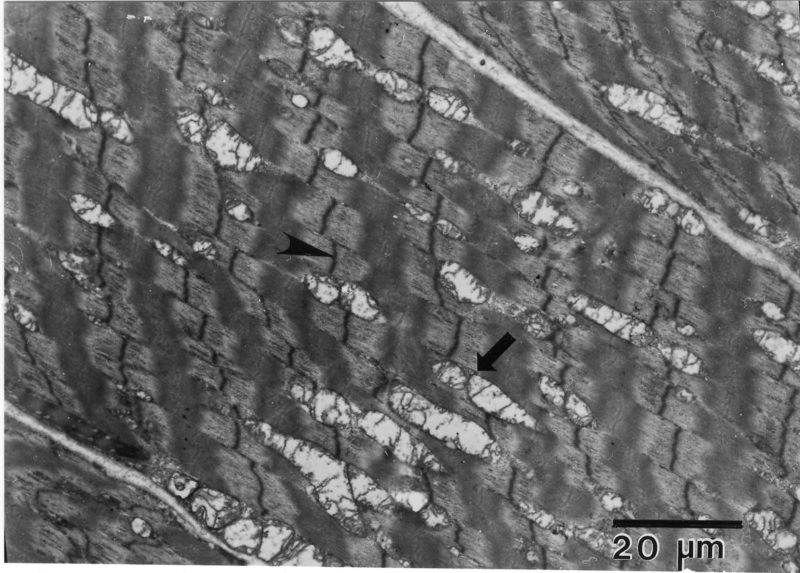Mitochondria are derived from bacteria more than 1.5 billion years ago, and exist today as symbionts within almost all of our cells. The mitochondria produce the vast majority of the energy (ATP) made by cells. Human life is impossible without mitochondria.
All cells require energy to perform most of their needs. This ubiquitous nature of energy metabolism explains why mitochondrial disease or dysfunction can present as pathology in many different tissues and organs. However, since nerve cells are electrical, and muscle cells perform work, disorders of nerve and muscle are the most common manifestation of mitochondrial disease. All of the various nerves and muscles throughout the body potentially can be affected, leading to many different signs and symptoms. A partial list of disorders that can result from mitochondrial disease is shown below in a table adapted from the United Mitochondrial Disease Foundation website (www.umdf.org). While disease involving many different tissues and organs are listed, it is evident that disorders of nerve and muscle predominate, and are often “functional”. Most patients with mitochondrial disease/dysfunction have several different manifestations of disease reflecting deficient energy metabolism in tissues throughout the body.
Brain
- Developmental delays
- Dementia
- Neuro-psychiatric disturbances
- Migraines
- Autistic Features
- Mental retardation
- Seizures
- Atypical cerebral palsy
- Strokes
Nerves
- Weakness (may be intermittent)
- Absent reflexes
- Fainting
- Neuropathic pain
- Dysautonomia – temperature instability
Muscles
- Weakness
- Cramping
- Gastrointestinal problems
- Dysmotility
- Irritable bowel syndrome
- Hypotonia
- Muscle Pain
- Gastroesophogeal reflux
- Diarrhea or constipation
- Pseudo-obstruction
Kidneys
- Renal tubular acidosis or wasting
Heart
- Cardiac conduction defects (heart blocks)
- Cardiomyopathy
Liver
- Hypoglycemia (low blood sugar)
- Liver failure
Ears and Eyes
- Visual loss and blindness
- Ptosis
- Ophthalmoplegia
- Optic atrophy
- Hearing loss and deafness
- Acquired strabismus
- Retinitis pigmentosa
Pancreas and other glands
- Diabetes and exocrine pancreatic failure (inability to make digestive enzymes)
- Parathyroid failure (low calcium)
Systemic
- Failure to gain weight
- Fatigue
- Unexplained vomiting
- Short stature
- Respiratory problems
Most, if not all, of the conditions listed on this slide can be caused by other conditions other than mitochondrial disease. For example, migraine has many different causes. Even in a patient with proven mitochondrial disease who suffers from migraine, migraine is not solely caused by the defective mitochondria. There are other factors as well, both genetic and environmental. However, identifying mitochondrial disease as one factor leading to migraine suggest that mitochondrial-targeted therapies might be helpful as part of treatment. In my clinical experience, this is indeed generally the case.
Mitochondrial disease or mitochondrial dysfunction – Is there a difference? “Mitochondrial dysfunction” simply means that the mitochondria are not working properly. It is usually diagnosed based on laboratory testing showing abnormal concentrations of certain metabolites that suggest incomplete mitochondrial metabolism. In many of those patients, the underlying problem is in the mitochondria, and the mitochondrial dysfunction is said to be “primary”. These patients are commonly labeled as having “mitochondrial disease”. In many other cases, the underlying problem is NOT in the mitochondria, but elsewhere in the cell, and the mitochondrial dysfunction is said to be “secondary”. There are many defects outside of the mitochondria that can cause mitochondrial dysfunction. A common example is a “channelopathy”, which are caused by mutations in genes that encode ion channels. However, regardless of whether mitochondrial dysfunction is primary or secondary, in my clinical experience, the patient generally responds favorably to mitochondrial-targeted therapies.
In Mitochondrial Medicine, disease is evaluated not only evaluated in terms of local pathology, but also in terms of deficiencies and imbalances of metabolism, such as inadequate ATP, increased free radicals/ROS (reactive oxygen species), and/or specific nutritional deficiencies or toxicities. Testing is performed to confirm the presence of mitochondrial dysfunction, locating the underlying causes or factors leading to disease, and identifying any deficiencies. Treatment is aimed at mitochondrial dysfunction in general, the underlying causes/factors related to disease (if identified), and the symptoms that are bothering the patient. For example, in the example of a patient with mitochondrial dysfunction with migraine, treatment would be aimed at the mitochondrial disease (both in general and for the specific type identified), and at migraine.


